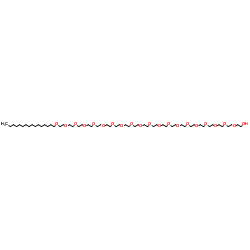Brij-C20

Brij-C20 structure
|
Common Name | Brij-C20 | ||
|---|---|---|---|---|
| CAS Number | 9004-95-9 | Molecular Weight | 1123.492 | |
| Density | 1.0±0.1 g/cm3 | Boiling Point | 926.7±60.0 °C at 760 mmHg | |
| Molecular Formula | C56H114O21 | Melting Point | 41-49ºC | |
| MSDS | Chinese USA | Flash Point | 514.2±32.9 °C | |
|
Antimicrobial Nanoemulsion Formulation with Improved Penetration of Foliar Spray through Citrus Leaf Cuticles to Control Citrus Huanglongbing.
PLoS ONE 10 , e0133826, (2015) Huanglongbing (HLB) is the most serious disease affecting the citrus industry worldwide to date. The causal agent, Candidatus Liberibacter asiaticus (Las), resides in citrus phloem, which makes it difficult to effectively treat with chemical compounds. In thi... |
|
|
Preparation of extracts from yeast.
Meth. Enzymol. 182 , 154, (1990)
|
|
|
TLR adaptor MyD88 is essential for pathogen control during oral toxoplasma gondii infection but not adaptive immunity induced by a vaccine strain of the parasite.
J. Immunol. 181(5) , 3464-73, (2008) TLR adaptor MyD88 activation is important in host resistance to Toxoplasma gondii during i.p. infection, but the function of this signaling pathway during oral infection, in which mucosal immunity assumes a predominant role, has not been examined. In this stu... |
|
|
A comparative study of two different assay kits for the detection of secreted alkaline phosphatase in HPV antibody neutralization assays.
Hum. Vaccin. Immunother. 11(2) , 337-46, (2015) To assess immunogenicity and development of antibodies in the context of vaccination, it is critical to quantify titers of neutralizing antibodies. We have been employing the 293TT cell-based neutralization assay system to quantify anti-HPV neutralizing antib... |
|
|
Comparative study on toxic effects induced by oral or intravascular administration of commonly used disinfectants and surfactants in rats.
J. Appl. Toxicol. 32(7) , 480-7, (2012) Accidental ingestion or injection of household products sometimes occurs due to their accessibility, but the toxic manifestations have not been well characterized when they are internally administered. The aim of this study was to investigate the toxic effect... |
|
|
DNA and protein footprinting analysis of the modulation of DNA binding by the N-terminal domain of the Saccharomyces cerevisiae TATA binding protein.
Biochemistry 46 , 9886-98, (2007) Recombinant full-length Saccharomyces cerevisiae TATA binding protein (TBP) and its isolated C-terminal conserved core domain (TBPc) were prepared with measured high specific DNA-binding activities. Direct, quantitative comparison of TATA box binding by TBP a... |
|
|
Effect of surfactants and pH on naltrexone (NTX) permeation across buccal mucosa.
Int. J. Pharm. 411(1-2) , 92-7, (2011) The objective of this pre-formulation study was to systematically investigate the effects of two surfactants (Brij 58(®) and Tween 80(®)) and change in solution pH on in vitro permeation of naltrexone HCl (NTX-HCl) across tissue engineered human buccal mucosa... |
|
|
The effect of detergents on trimeric G-protein activity in isolated plasma membranes from rat brain cortex: Correlation with studies of DPH and Laurdan fluorescence
Biochim. Biophys. Acta 1788(2) , 324-32, (2009) The effect of non-ionic detergents on baclofen (GABA B-R agonist)-stimulated G-protein activity was measured as a [ 35S]GTPγS binding assay in the plasma membranes (PM) isolated from the brain tissue. The effect was clearly biphasic — a decrease in the activi... |
|
|
Microdomains of endoplasmic reticulum within the sarcoplasmic reticulum of skeletal myofibers.
Exp. Cell Res. 314(2) , 237-45, (2008) The relationship between the endoplasmic reticulum (ER) and the sarcoplasmic reticulum (SR) of skeletal muscle cells has remained obscure. In this study, we found that ER- and SR-specific membrane proteins exhibited diverse solubility properties when extracte... |
|
|
Investigating the location of propyl gallate at surfaces and its chemical microenvironment by (1)H NMR.
Lipids 42(6) , 561-72, (2007) The location and the resulting chemical microenvironment of the antioxidant propyl gallate (PG) was studied in micellar solutions using the cationic emulsifier cetyl trimethyl ammonium bromide (CTAB), the anionic emulsifier sodium dodecyl sulphate (SDS) and t... |